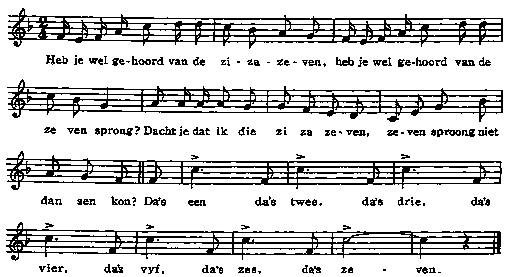Folk & Traditional Music of the Western Continents
The folk & traditional music of Europe, Africa & the Americas explored.
| Share page | Visit Us On FB |
|
THE GERMANIC PEOPLES 6$ |
||
|
|
||
|
Christian ceremonies involving the life cycle or the changes in the year's cycle. Kunst reports seeing the Seven Saults still performed in the twentieth century on the Dutch island of Terschelling. It involves seven motions of a mildly acrobatic nature: stamping with each foot, touching the ground with each knee, then with each elbow, and finally with the nose. It was evidently performed—as are many European folk dances—with the accompaniment of group singing, such as that found in Example 4-7. |
||
|
|
||
 |
||
|
|
||
|
example 4-7. Dutch folk dance tune, from Jaap Kunst, "On Dutch Folk Dances and Dance Tunes" in Studies in Ethnomusicologyy ed. M. Kolinski (New York: Oak Publications, 1961), vol. 1, p. 32.
The tune in Example 4-7 shows us some of the traits common in Western European folk dance music. Of course, since the music is used for dancing, and since it is sung by a group, it could not easily partake of the parlando-rubato singing style with its distortion of tempo and emphasis on words. It tends to be rigid in this aspect of music, to have simple rhythms consisting largely of two- or three-note values (as in this case, quarter, eighth, and sixteenth notes). This tune also is in major, with an implication of harmony in the Western tradition, based on tonic, subdominant, dominant, and dominant seventh chords.
Holland, being near the center of the Germanic-speaking area, exhibits musical relationships to England, Germany, and Scandinavia. In the field of dance and dance music, a number of similarities be- |
||